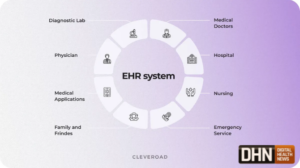 As digital transformation continues to reshape healthcare, terms like Hospital Information System (HIS) and Electronic Health Record (EHR) are often used interchangeably. But despite some overlap, these systems serve different purposes and functions within the healthcare ecosystem.
As digital transformation continues to reshape healthcare, terms like Hospital Information System (HIS) and Electronic Health Record (EHR) are often used interchangeably. But despite some overlap, these systems serve different purposes and functions within the healthcare ecosystem.
In this guide, we’ll break down the key differences, similarities, and complementary roles of Hospital Information Systems and Electronic Health Records. Whether you’re a healthcare IT decision-maker or just exploring healthcare tech, understanding this distinction is essential.
Table of Contents
- What Is a Hospital Information System (HIS)?
- What Is an Electronic Health Record (EHR)?
- HIS vs. EHR: Key Differences
- How HIS and EHR Work Together
- Benefits of Integrating HIS and EHR
- Which One Does Your Facility Need?
- Future Trends: HIS and EHR in 2025 and Beyond
- Final Thoughts
1. What Is a Hospital Information System (HIS)?
A Hospital Information System is an integrated software platform that manages the administrative, operational, and clinical functions of a hospital or healthcare facility. It connects various departments—from billing to radiology—into one centralized system.
Core Features of a HIS:
- Patient registration and scheduling
- Billing and insurance management
- Inventory and supply chain control
- Lab and imaging integration
- Pharmacy management
- Human resources and payroll
- Financial reporting
- Clinical documentation and decision support
A modern HIS is designed to ensure that everything from patient admission to discharge is coordinated and optimized for efficiency.
2. What Is an Electronic Health Record (EHR)?
An Electronic Health Record is a digital version of a patient’s paper chart. It contains comprehensive health data that can be shared across healthcare providers and systems.
Core Features of an EHR:
- Patient demographics
- Medical history and allergies
- Lab test results
- Medication history
- Treatment plans
- Immunization records
- Clinical notes and progress reports
The main goal of an EHR is to improve clinical outcomes by providing healthcare professionals with real-time access to accurate patient data.
3. HIS vs. EHR: Key Differences
Let’s break down the fundamental differences between a Hospital Information System and an Electronic Health Record:
| Feature | Hospital Information System (HIS) | Electronic Health Record (EHR) |
|---|---|---|
| Scope | Organization-wide (admin, finance, clinical) | Patient-specific clinical data |
| Purpose | Manage hospital operations | Improve patient care |
| Users | Admins, finance teams, doctors, nurses | Doctors, nurses, specialists |
| Modules | Billing, HR, pharmacy, inventory, EMR | Clinical notes, test results, diagnosis |
| Integration | Includes EHR/EMR modules | Can be part of or standalone from HIS |
| Access Level | Multi-departmental | Focused on clinical care team |
| Data Type | Operational + Clinical | Clinical only |
4. How HIS and EHR Work Together
While HIS and EHR serve different functions, they complement each other within a digital health ecosystem.
Here’s how they interact:
- A patient registers via the HIS, and their demographic data is stored.
- Clinical care is documented in the EHR module, which may be part of the HIS or a separate system.
- Lab results from the LIS (within HIS) are uploaded to the patient’s EHR.
- The billing module in the HIS generates invoices based on services recorded in the EHR.
When integrated properly, HIS provides the infrastructure, and EHR ensures continuity and quality of care.
5. Benefits of Integrating HIS and EHR
In 2025, healthcare facilities are moving toward full integration of HIS and EHR platforms. Here’s why:
✅ Unified Data Access
All departments—from radiology to billing—can access consistent patient data.
✅ Improved Patient Care
Doctors get a holistic view of a patient’s history, leading to better clinical decisions.
✅ Operational Efficiency
Administrative and clinical workflows are streamlined, saving time and reducing errors.
✅ Enhanced Reporting & Analytics
Data from both systems can be used to track patient outcomes, hospital performance, and financial health.
✅ Regulatory Compliance
Integrated systems make it easier to comply with standards like HIPAA, GDPR, and HL7.
6. Which One Does Your Facility Need?
The short answer? Both.
If you run a full-scale hospital or multi-specialty clinic, a Hospital Information System is essential for operational efficiency. However, if your primary focus is on outpatient care or private practice, a standalone Electronic Health Record system might suffice.
Choose a HIS if you need:
- End-to-end hospital management
- Centralized control of all departments
- Administrative + clinical functionality
Choose an EHR if you need:
- Detailed clinical records
- Standalone clinical workflows
- Interoperability with other providers
For best results, look for modular HIS solutions that include EHR functionality or support integration with third-party EHRs.
7. Future Trends: HIS and EHR in 2025 and Beyond
Healthcare technology is rapidly evolving. Here’s what to expect in the future:
🌐 Cloud-Based Systems
Cloud technology allows hospitals to scale operations, reduce IT costs, and enable remote access.
🤖 AI Integration
Artificial Intelligence supports clinical decision-making, billing automation, and predictive analytics.
🔗 Interoperability
Standards like HL7 FHIR are improving how HIS and EHR systems communicate with each other—and with external platforms.
🧠 Patient-Centered Design
More EHRs are adopting patient portals, giving individuals direct access to their medical records and the ability to participate in care decisions.
🔒 Advanced Security
With rising cybersecurity threats, HIS and EHR platforms are investing in blockchain, two-factor authentication, and encrypted data storage.
8. Final Thoughts
Understanding the difference between a Hospital Information System and an Electronic Health Record is critical for healthcare professionals, IT leaders, and administrators.
While an EHR focuses on the clinical aspect of patient care, a HIS encompasses the entire hospital ecosystem—from appointment scheduling and pharmacy to finance and reporting.
In 2025, integrating HIS and EHR systems isn’t just a technological upgrade—it’s a strategic necessity for delivering smarter, safer, and more efficient healthcare.